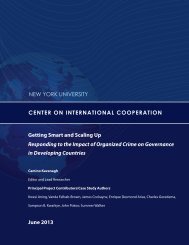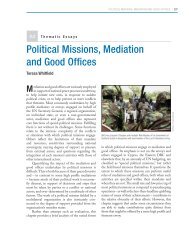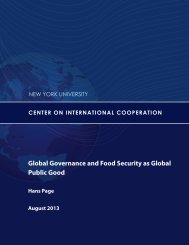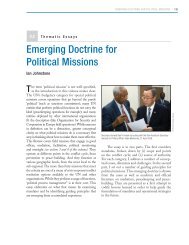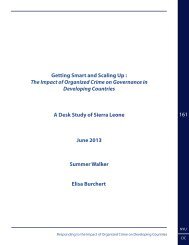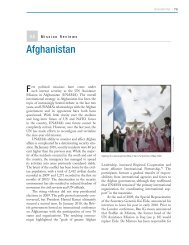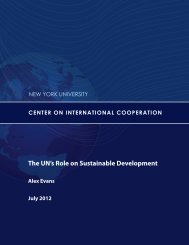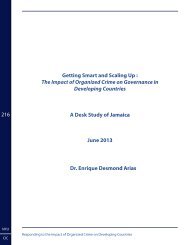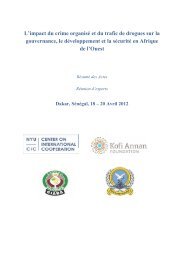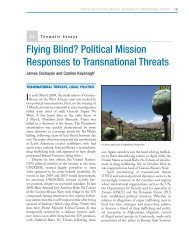here - Center on International Cooperation - New York University
here - Center on International Cooperation - New York University
here - Center on International Cooperation - New York University
Create successful ePaper yourself
Turn your PDF publications into a flip-book with our unique Google optimized e-Paper software.
these challenges within government or limited voices<br />
and limited leverage am<strong>on</strong>g external actors to increase<br />
political pressure to advance reform efforts.<br />
2. Typology analysis 58<br />
Based <strong>on</strong> our own research and the core areas we have<br />
identified for targeted programming, we have also<br />
developed the opti<strong>on</strong> of a typology analysis framework,<br />
grouping forms of organized crime/politics relati<strong>on</strong>s into<br />
two broad typologies: enclave or mafia. The framework<br />
is sharply underpinned by the ‘do no harm’ principle and<br />
could, with more research and field testing, be coupled<br />
with a political ec<strong>on</strong>omy assessment such as the <strong>on</strong>e<br />
suggested above, to set the broad outlines for an organized<br />
crime-sensitive development strategy. For now, we do not<br />
argue that any of our cases studies fit neatly or entirely<br />
within either <strong>on</strong>e of these ‘ideal types’. Different aspects<br />
may be present in <strong>on</strong>e country at the same time, or the<br />
dynamics of a country may force a shift from <strong>on</strong>e ideal<br />
type to the other. The ideal types should be seen merely as<br />
analytical lenses, whose use in examining specific country<br />
cases may help draw out certain aspects of the impact of<br />
organized crime <strong>on</strong> governance, t<str<strong>on</strong>g>here</str<strong>on</strong>g>by improving the<br />
prospects of effective, do no harm-based development<br />
interventi<strong>on</strong>s. The typology analysis could also serve as a<br />
useful framework for determining priority acti<strong>on</strong>s within<br />
the five areas outlined above. Through further research,<br />
c<strong>on</strong>ceptual development and testing, similar frameworks<br />
may provide a basis for more sophisticated analytical and<br />
program<br />
Enclave Scenarios<br />
Some organized crime groups – including gangs, drug<br />
cartels, and warlords – use violence to develop and retain<br />
c<strong>on</strong>trol over territorial or social enclaves within states,<br />
such as Jamaica’s garris<strong>on</strong> neighborhoods, Brazil’s favelas,<br />
or hinterland communities in Somalia, Afghanistan, and<br />
Myanmar. Mark Duffield has described rulers of these<br />
enclaves as local str<strong>on</strong>gmen able to c<strong>on</strong>trol an area and<br />
exploit its resources while, at the same time, threatening<br />
58. The following secti<strong>on</strong> was developed by James Cockayne, <strong>on</strong>e of the principal c<strong>on</strong>tributors<br />
to the research project. The examples provided are drawn from the case studies but have not<br />
been tested in-country. For further discussi<strong>on</strong> <strong>on</strong> the approach, see Cockayne, ‘Chasing Shadows:<br />
Strategic Resp<strong>on</strong>ses to Organized Crime in C<strong>on</strong>flict-Affected Situati<strong>on</strong>s’, RUSI Journal, April 2013,<br />
vol. 158, no. 2.<br />
central authority or keeping it weak. 59 In these cases, an<br />
organized criminal group can take advantage of the state’s<br />
weak territorial, social, or administrative reach to assume a<br />
governance role within a defined enclave within the state.<br />
As Desm<strong>on</strong>d Arias describes, states can – and frequently do<br />
– extend c<strong>on</strong>trol over these enclaves through incorporating<br />
these str<strong>on</strong>gmen into the political order, creating a system<br />
of “violent pluralism”. 60 This produces a kind of political<br />
settlement based <strong>on</strong> indirect rule through criminal proxies<br />
and local powerbrokers. 61 Our research highlights the<br />
prevalence of such systems in Latin America and Caribbean,<br />
and points to signs of a related, but somewhat different<br />
system emerging in Nepal, as Box 1 below explains.<br />
Box 1: Enclaves and Violent Pluralism – from<br />
Kingst<strong>on</strong> to Kathmandu<br />
Armed gangs with historic affiliati<strong>on</strong>s to Jamaica’s political<br />
parties dominate working class neighborhoods in the Kingst<strong>on</strong><br />
and Saint Andrews Corporate Area and the neighboring<br />
municipality of Spanish Town. These armed groups c<strong>on</strong>trol<br />
‘garris<strong>on</strong>’ communities, delivering voting blocs to Jamaica’s<br />
two main political parties, while using the communities as<br />
enclaves for drug trafficking, extorti<strong>on</strong>, and violent crime. 62<br />
In many cases, local criminal leaders also seek to c<strong>on</strong>trol the<br />
structure of local state spending in the areas they dominate,<br />
deciding who will work <strong>on</strong> street repair projects or <strong>on</strong> the yearly<br />
efforts to clear the gullies running through the city to prevent<br />
flooding during the rainy seas<strong>on</strong>, and c<strong>on</strong>trolling government<br />
c<strong>on</strong>structi<strong>on</strong> c<strong>on</strong>tracts within those neighborhoods. These<br />
gangs also have c<strong>on</strong>tacts with Jamaicans engaged in illegal<br />
activities abroad. Transnati<strong>on</strong>al networks support small-scale<br />
smuggling operati<strong>on</strong>s with Jamaicans sending drugs to the<br />
United States, Canada, and the United Kingdom, and importing<br />
arms mostly from the United States and Haiti. Funds from these<br />
c<strong>on</strong>tacts help criminal organizati<strong>on</strong>s offer limited social services<br />
to local residents and provide for a measure of independence<br />
from elected officials. Like many criminal str<strong>on</strong>gmen in Latin<br />
59. Mark Duffield (1998), “Post-modern C<strong>on</strong>flict: Warlords, Post-adjustment States and Private<br />
Protecti<strong>on</strong>,” in Civil Wars, Vol. 1, pp. 65-102: p. 81.<br />
60. Desm<strong>on</strong>d Enrique Arias, “Understanding Criminal Networks, Political Order, and Politics in Latin<br />
America,” pp. 115-135; See also Schulte-Bockholt, Alfredo (2006), The Politics of Organized Crime and<br />
the Organized Crime of Politics, Lanham MD/Oxford: Lexingt<strong>on</strong> Books.<br />
61. Mónica Serrano (2002), “Transnati<strong>on</strong>al Organized Crime and Internati<strong>on</strong>al Security: Business as<br />
Usual?” in Mats Berdal and Mónica Serrano (eds.), Transnati<strong>on</strong>al Organized Crime and Internati<strong>on</strong>al<br />
Security: Business as Usual?, Boulder CO: Lynne Rienner, pp. 21-22; A. Smart, ‘Predatory Rule and<br />
Illegal Ec<strong>on</strong>omic Practices’, in J. M. Heyman (ed.), States and Illegal Practices, Oxford: Berg, 1999.<br />
62. Anth<strong>on</strong>y Harriott (1996), “The Changing Social Organizati<strong>on</strong> of Crime and Criminals in Jamaica,”<br />
in Caribbean Quarterly, Vol. 42, No. 2/3, pp. 68-69.<br />
33<br />
Resp<strong>on</strong>ding to the Impact of Organized Crime <strong>on</strong> Developing Countries<br />
NYU<br />
CIC



